Reactions of [Mn6O2(piv)10(py)2.5(piv)1.5], Ln(NO3)3·6H2O and N-mdeaH2 in MeCN in the presence of Me3SiCl generated a family of octanuclear Mn/Ln complexes [Mn6IIIMnIILn(N-mdea)3(N-mdeaH)(piv)8O2(OH)3(NO3)(H2O)]·xCH3CN·xH2O [Ln = Gd (1), Dy (2), Er (3), pivH = pivalic acid, N-mdeaH2 = N-methyl diethanolamine]. Each complex possesses a [Mn6IIIMnIILn(μ3-O)2(μ3-OH)3]16+ core containing two butterfly-like subunits of [Mn3Ln(μ3-OH)2] and [Mn4(μ3-O)2] sharing a common vertex, and an outer Mn atom ligated to one of the subunits through a μ3-OH− ligand. The core topology represents a new Mn/Ln core type. The magnetic susceptibility study of 1–3 indicates the presence of dominant antiferromagnetic interactions within the complexes. For complex 1, which contains an isotropic GdIII atom, fitting of the obtained M/(NμB) vs. H/T data gave S = 4, g = 1.90, and D = −0.31 cm−1. The results were further supported by ac data. Complex 3 exhibits out-of-phase ac susceptibility signals, indicating it may be a SMM.

You have access to this article
 Please wait while we load your content...
Something went wrong. Try again?
Please wait while we load your content...
Something went wrong. Try again?


 Please wait while we load your content...
Please wait while we load your content...